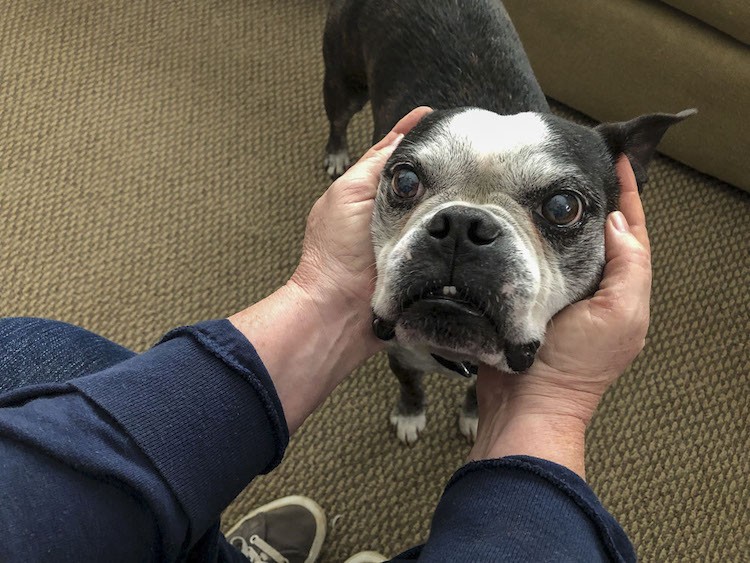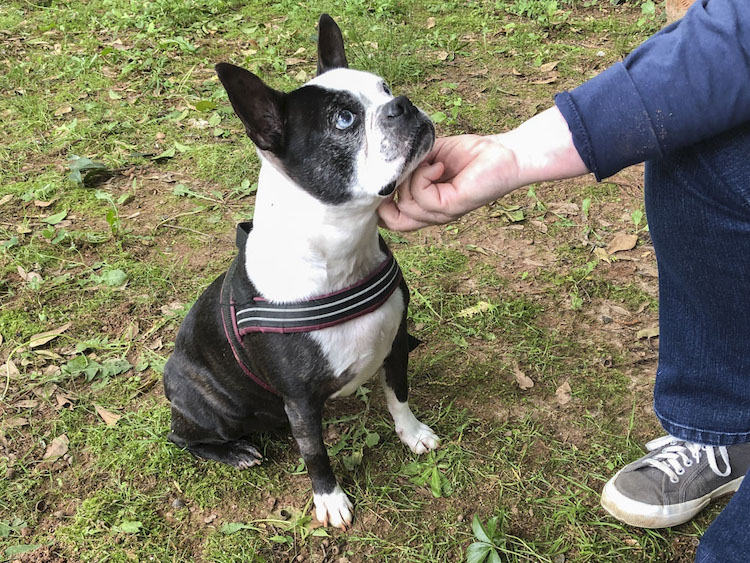I see a dog and want to pet them. Immediately. Do You?
It’s natural, I think. Or maybe we are all conditioned that way, but nevertheless – when you meet your foster dog you will have the urge to reach out and give that dog some love.
You want to let that dog know that everything is going to be OK and that they are safe and loved. But should you?
What’s the best way to touch your foster dog?
What if you are fostering a fearful dog that doesn’t like to be touched? How do you help foster dogs get used to being touched?
Is there a best way to touch your foster dog?
My most recent foster dog, Carter, snapped at a few people after he asked them to pet him. This behavior really confused me, because he’s a friendly dog. In order to understand his behavior more, I asked my trainer to help me out, and she and I had a good conversation about touch.
Truth is, dogs don’t always like to be petted, or more specifically, they may not like to be petted the way we think they like to be petted. Some dogs don’t like to be touched at all, and that can be a problem.
Touch Your Foster Dog – What Are The Benefits?
We receive benefit when we pet dogs. It’s why our urge to pet them is so strong.
There have been plenty of scientific studies done on the benefits humans receive from petting dogs. We like it, and we figure dogs like to be touched, too.
I thought I could easily find a few scientific studies that showed how petting a dog benefitted the dog. While I found a few articles that talked about comforting a pet who is nervous or stressed, I didn’t find any scientific studies that proved that petting had any physiological benefit to dogs. Therapeutic touch does, but that’s different, and I’ll cover that further down the post.
So, I have to say the benefit dogs receive from petting is enjoyment, sometimes. Some dogs enjoy being petted, some do not enjoy being petted, and some dogs, like Carter, have some rules around how he prefers to be petted.
Is touching our foster dog the only way we can let dogs know that we love them? I don’t think so. I think we have many ways we can let dogs know they are safe and loved without touch or petting.
Indeed, my current, long-term foster dog, Sassy has storm anxiety. One of the recommendations for helping her during storms is to touch her and offer her comfort. Nope. Sassy does not want to be near me when she’s upset over the weather. She prefers to pace. Touch during storms doesn’t help her at all.
It is important to touch your foster dog.
Or, maybe more importantly, it’s important to make touch available to your foster dog.
- Touch is a way to help build trust between you and your foster dog. Dogs often groom their animal companions in a display of affection. In a similar way, dogs feel connected to humans by our touching them.
- Touch is pleasurable to most dogs. My foster-fail dog, Otis, loves to be petted and touched. He’s pushy about it, too! He will sit on my lap and I’ll pet him. When I stop, he paws at my hand telling me to pet him again. And again. And again!
Sassy, on the other hand, visits me at my desk multiple times during the day, asking for a quick petting, then she walks away. Carter preferred to snuggle rather than be petted continuously. It took some unlearning for me to have him lay close to me and not pet him frequently.
While touch is pleasurable to most dogs, there are many dogs who don’t particularly like to be petted by someone they don’t know.
If you are meeting your foster dog for the very first time, use the Canine Consent Test! Go slow, and let your foster dog give permission to be petted.
This same rule applies when you are ready to take your foster dog out into the community. Your dog may meet lots of strangers. Give them a voice! Let them decide if they want to be petted or not. - Petting is a positive reinforcer. Petting is an effective tool when training your foster dog. According to a study published in Behavioural Processes, (Jan 2015) Erica N. Feuerbacher and Clive D.L. Wynne found that dogs actually preferred physical touch for reward over verbal praise. If you enjoy reading science like I do, check out the abstract, it’s fascinating!
I don’t think the article was suggesting to stop using verbal praise, but instead are suggesting we add physical touch in our repertoire of positive reinforcers. I use physical touch and verbal praise at the same time. - In a stressed or anxious animal, touch can help calm them. But, use your observation skills.
Touch can increase stress in a dog that is too stressed. Pay attention to the dog’s body language and use the Canine Consent Test. The Canine consent test is an easy-to-learn technique that allows a dog to tell you if they want to be petted. How cool is that? - You can discover lumps, bumps, or other findings. I foster dogs that frequently develop lumps or growths that need evaluation. In addition, if a benign lump, such as a lipoma is present on my foster dog, I need to regularly measure that growth in the event it’s getting bigger. Once weekly, I do skin checks while I touch my foster dog.
Here’s how I do a skin check on dogs.
- You assess a dog’s tolerance for grooming and vet exams. Ears, teeth, nails, and certain coats need regular attention. This means your foster dog needs a human to touch them. It means your foster dog may need to accept equipment like nail clippers, toothbrushes, ear drops, etc. Also called husbandry, most rescued dogs haven’t had their teeth regularly brushed or their toenails regularly.
- You discover any sensitive areas on your foster dog’s body. Dogs are usually pretty stoic about their pain levels. Sometimes, we have no clue that a dog is in any discomfort until we come upon a tender spot during touch. Alternately, we can witness other signs of pain or discomfort, report these to our veterinarian who can perform a physical exam.
Sassy has spondylosis in her spine; she responds if I touch her spine around a few particular vertebrae, letting me know she feels discomfort. One of my foster homes was caring for a dog who’d snap at her when she went to put a collar on the dog’s neck. We first thought it was because the dog had never worn a collar before or maybe something unkind had happened to the dog in the past.
Turns out, the dog had a compressed disc in it’s neck, and the dog was anticipating pain. We ruled out medical reasons for a behavioral problem and we were able to provide appropriate treatment. - You discover your dog’s familiarity with equipment such as collars, leashes, and harnesses. Take your foster dog’s collar, leash, harness on and off. If you sense fear or hesitancy or cowering, you’ve uncovered an important bit of information about your foster dog and you have a potential area for training or management. Ignoring fear responses can end up triggering a bite.
All bites are significant bites because a dog will use biting as one way to communicate. Carter only air-snapped at a few people, never causing an injury. Still, his behavior is significant according to Dr. Dunbar’s Bite Scale. While Carter’s prognosis is really good, if I chose to blow off an air snap as no big deal, Carter might have elevated his biting behavior to something more serious. It was my responsibility to do my best to understand what was making Carter unhappy enough that he thought he needed to snap at people who were petting him.
How To Touch Your Foster Dog The First Time
You want to start your relationship with your foster dog on the right foot, and that begins with a good introduction. With a slow pace, careful observation, giving the dog permission to engage or disengage will all contribute to a respectful, comfortable and successful introduction.

- Dogs have preferred places where they like to be petted. Especially when they are being petted by strangers. Quick pats to the top of the head or heavy bouts of physical affection from strangers may not be pleasant to a dog.
Instead, dogs enjoy gentle, long strokes or they might enjoy light scratches under their chin or around their jowls. When you pet your foster dog, give frequent breaks after just 2-3 seconds of petting to allow your foster dog to either ask you for more petting or just walk away. Try this! I think you’ll be surprised to witness how many dogs walk away after a 3-second chin scratch! - Dogs don’t particularly like being petted on top of their heads. In fact, often dogs will follow your hand with their eyes, raising their noses upward as you reach out to pet them between the ears. Try scratching under the snout or on the dog’s chest instead.
- Dogs also don’t like for you to grab their head with both hands and move in for a big kiss on the forehead. You might be able to do this with your personal dogs, and in time you might be able to touch your foster dog in this manner but not at first.
A vet tech did this to Carter within 30 seconds of meeting her, and she’s lucky he only air snaps! I know much more about touch now than I did then, or I would have intervened. That incident gave Carter a “bite record” even though he didn’t cause any injury. - Pay attention to your body language. If you can remember, position your body and stand sideways, or with your body at an angle to the foster dog instead of standing straight ahead, facing the dog. Standing at an angle is less threatening.
Try to not tower over a dog and reach down and over them to pet them. Seeing a strange person loom down over them can make a dog feel uneasy. You want that first introduction to be nothing but pleasant and fear-free. If possible, you may want to try and find a chair or stool and sit at an angle. or if you are comfortable, sit on the ground!

- Use the Canine Consent Test. I know I keep mentioning this test, but to me, it is so important to use this technique that I want to make sure you don’t overlook it in this post. The last thing you want to do is to overwhelm your new foster dog on the very first day.
The Canine Consent test gives your foster dog a voice, and I think that’s a great way to lay the foundation for your relationship with this dog.
Advanced Touch Skills!
There are ways to therapeutically touch your foster dogs. Practitioners are easier to find than they were a couple of decades ago, or go for it! Become a certified practitioner yourself.
Acupressure
Acupressure is the use of light pressure touch to stimulate the nervous system, enhance blood flow to promote healing, and can promote relaxation. It is similar to acupuncture, but instead of using fine needles, acupressure is performed by using a thumb or forefinger at pressure points on the body.
Acupressure is potentially beneficial for anxiety, arthritis and other joint issues, pain, epilepsy, digestive issues, boosting the immune system, and even improving focus. Explore if this type of touch is good for your foster dog.
Certifications in Acupressure are available through animal massage schools.
Massage
While acupressure works at specific pressure points on the dog’s body, massage is working with the dog’s soft tissue. Massage can be beneficial in many ways: reducing stress, improving a calm state, reducing pain, improving flexibility, promoting healing, and stimulate the nervous system.
You can be taught some massage techniques, but the best outcomes will occur if you use a professional canine massage therapist, should your dog need that. But what a cool job – massaging dogs all day!
Do ask about performing massage on your dog before you decide to go ahead, thinking it will help. There are certain medical conditions and injuries where massage is contraindicated and should not be done. Check with your veterinarian or rehabilitation practitioner, first.
T-Touch
T-Touch, or the Tellington Method is a unique form of touch created by Linda Tellington-Jones. T-Touch is promoted as a method to deepen a relationship and bond between human and dog, improve health and well-being, address behavioral issues, and increase a dog’s motivation to learn.
If you are interested in learning more about becoming a T-Touch practitioner, click HERE.
The best way to touch your foster dog.
Hopefully, you feel more confident and aware of the ways you can touch your foster dog help understand your foster dog and improve a rescue dog’s journey toward their new life. By skillfully helping your foster dog comfortably receive petting from others and how to help other safely pet your foster dog you set your foster dog up for success.
Just like humans, dogs approach social situations differently and not all dogs are enthusiastic about greeting strangers or handling excessive petting. Go slow, let the dog have a voice, give frequent breaks, and don’t ask your dog to do more than they want with regard to being handled and petted.

Extra Credit Reading
What To Think About When Petting Your Dog
Petting Dogs: Why Consent Is Important
The Right Way To Introduce Yourself To A New Dog
Canine Massage, Acupressure and T-Touch
Popular Posts
How To Foster Dogs – 10 Skills You Need To Know
How To Choose A Dog Rescue Agency
Let Your Foster Dog Go – Tips For Adoption




